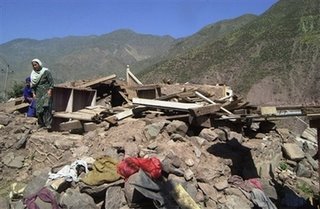Earthquake in Pakistan...so what?
 The topic of accountability reminded me of the discussion that was held in class a couple of weeks ago related to celebrities being accountable when they become advocates for a cause. We discussed the Tsunami telethon and where those donations ended up; we even compared the aid pledged by the U.S. in comparison to other countries.
The topic of accountability reminded me of the discussion that was held in class a couple of weeks ago related to celebrities being accountable when they become advocates for a cause. We discussed the Tsunami telethon and where those donations ended up; we even compared the aid pledged by the U.S. in comparison to other countries.Yesterday was the anniversary of the magnitude 7.6 earthquake in the Pakistan and India border that killed 80,000 people and destroyed 600,000 homes, 6,500 schools, 800 clinics/hospitals, and 4,000 miles of roads. Something that I wondered last year and still wonder today is, "Why did the victims of this earthquake not receive the outpouring of aid and press coverage that the victims of the Tsunami did?"
If I recall correctly, the Tsunami occurred the day after Christmas in 2004, with its relief efforts occurring early in 2005, then Katrina devastated New Orleans in August. Understandably, there was an enormous amount of aid and coverage for Katrina victims because they are our own. Then the earthquake happened in October, and although it was covered, I certainly did not see the same level of coverage that I did for the other two disasters. I don't think that there was a telethon to help the earthquake victims. Does this mean that in 2005, after "dealing" with the Asian Tsunami and Hurricane Katrina, the American public suffered from donation fatigue?
Here are a few paragraphs from the AP story on the anniversary of the earthquake (http://news.yahoo.com/s/ap/20061008/ap_on_re_as/quake_anniversary):
"But the IDPs (internally displaced people) we continue to serve tell us that the job is not over yet," said Kirsten Zaat, spokeswoman for the council's Pakistan-based operations. "Substantial humanitarian needs remain, and a predictably harsh Himalayan winter is just around the corner."
On the Indian side of disputed Kashmir — where more than 1,300 people were killed by the quake — hundreds of people staged a demonstration Sunday, complaining they had not received promised aid. A similar protest was staged in Islamabad on Saturday.
While hundreds of shiny tin roofs of makeshift shelters dot the tree-covered mountainsides, officials in Kashmir say only 5 percent of people will have finished permanent homes before winter arrives. Tens of thousands of people could migrate to tented camps from upland villages to escape the freezing weather.

1 Comments:
At 8:14 PM, October 09, 2006, Evelyn said…
Evelyn said…
Nadya, I am glad that you are presenting this topic for discussion. There are many natural disasters around the world that do not receive the media coverage and the international aid that they deserve and the Pakistan earthquake is just one example. I found out that not only the people in Pakistan were impacted by this earthquake but also people in India and Afghanistan. The BBC reported that in India nearly 1,400 have died and 5,000 people were injured.
This is a link to the BBC story http://news.bbc.co.uk/2/hi/south_asia/4322624.stm#ikashmir
First I wonder, do we know how many donations have the Pakistan government received? How much do people get? How does the government or nonprofits distribute donations to the survivors of the disaster? I was looking online and I came up with information from the government of Pakistan and nonprofits that are helping the earthquake victims. The information is confusing and it does not present any conclusion not even the United Nations know how much donations they have collected because donations go to many nonprofit organizations, so they do not present a final number (please correct me if you find the number). At this point I think I have more questions than answers: Who is in primarily in charge of the restoration of this country? Is it the UN, the Pakistani Government, the NGO’s?
Post a Comment
<< Home